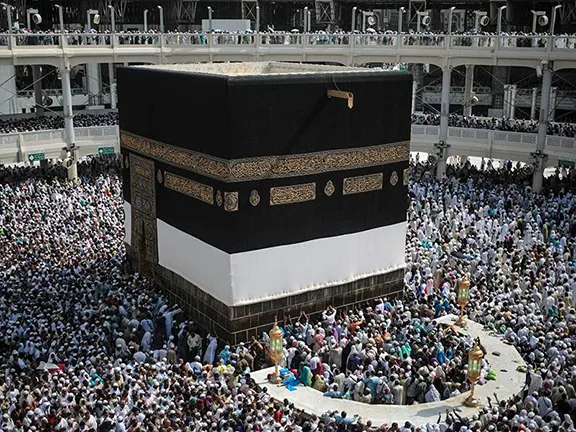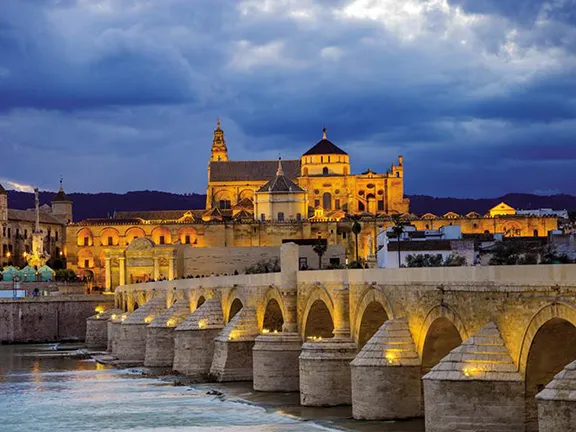Muslim Occupation of al-Andalus from 711 AD to 756 AD also known as the dependent emirate
By Nick Nutter | Updated 11 Apr 2023 | Andalucia | History |
Login to add to YOUR Favourites or Read Later


Berber tribesman
The period between 711 and 756 is called the dependent emirate because Muslim Spain, or al-Andalus, was dependent on the Umayyad caliph in Damascus. These years were marked by continuous hostilities between the different Arab factions and between the various social groups. The unconquered northern remnants of the Visigoth territories made their own contribution to Muslim unrest.
To recap briefly. A Moor, Tariq ibn Ziyad, with a Berber army, landed in Hispania in 711 AD. He found the Visigothic countryside in disarray and defeated a Visigothic army sent against him. Tariq's superior, Musa ibn Nusayr, an Arab general and Umayyad governor of North Africa, arrived in Hispania with reinforcements and the pair swiftly took over the entire Iberian Peninsula apart from a small section in the north.


Baghdad
Whether the Muslims intended to stay in al-Andalus is not clear, however the extensive fertile areas of the Guadalquivir, Guadiana and Ebro river valleys and the fertile coastal strip must have been a factor. Additionally the invasion was a useful way of occupying the recently conquered and converted Berbers of the Maghreb (North West Africa) with promises of riches, slaves and land.
From the first days of the occupation, the Muslims argued amongst themselves. The first governor of al-Andalus, Abd al-Aziz, Musa ibn Nusayr’s son, was decapitated in 715 and his head sent to Damascus after he tried to usurp power and declare himself ruler. Over the following forty years, al-Andalus had no less than twenty governors. Some were killed in expeditions into France, others were deposed and assassinated.
The Muslims also made a huge mistake by not completing the occupation and occupying the northern territories. The Pyrenees would then have provided an easily defendable frontier. As it transpired the Muslims allowed the roots of their final eviction to remain.
Seven years after the Muslim conquest of the Iberian Peninsula, a local Asturian named Pelayo fled to the extreme north of the peninsula. There, he is said to have established the Kingdom of Asturias. In the late summer of 722, a Muslim army overran much of Pelayo’s territory, forcing him to retreat deep into the mountains. Pelayo and 300 men retired into a narrow valley at Covadonga, a position from which they could defend against a broad frontal attack. Pelayo’s forces routed the Muslim army, inspiring local villagers to take up arms as well. Despite further attempts, the Muslims were unable to conquer Pelayo’s mountainous stronghold. Pelayo’s victory at Covadonga is hailed by some as the first victory of the Reconquista.


Haji in Mecca
In 740 AD, a major Berber uprising against their Arab leaders in North Africa had powerful repercussions in Muslim Spain. The Berbers had made up the majority of the forces in the Muslim armies throughout the Muslim expansion through North Africa and into the Iberian Peninsula yet were treated as second-class citizens by their Arab leaders. When land was confiscated from those who had opposed the invaders, the Arab leaders grabbed the prized land in fertile areas leaving the Berbers with the mainly mountainous areas around Granada, the hostile Duero valley and damp Galicia in the north west, and the Pyrenees in the north east. Berber victories in Morocco encouraged the Berbers in al-Andalus where they heavily outnumbered the Arab element of society. An immediate revolt was postponed in early 741 when the Arab elite in al-Andalus deposed the unpopular governor, Uqba ibn al-Hajjaj, and replaced him with Abd al-Malik ibn Katan al-Fihri, who was liked by both Berbers and Arabs.
However, in late 741, a Syrian army, including a detachment of elite Syrian cavalry, brought to Morocco to quell the uprising, were defeated at the Battle of Bagdoura near Fez. The remnants of the Syrian army, some 10,000 men with their leader Balj ibn Bishr, escaped to Ceuta where they were besieged by the Berber rebels. The news soon reached al-Andalus and encouraged the Berbers in the north-west of the Iberian Peninsula to discard their Arab commanders. They formed into three armies and marched south to try and take Toledo, Córdoba and Algeciras.


Cordoba
The immediate result of the departure of the Berbers from their garrisons in the northwest was not foreseen by the Berbers or the ruling Arabs. The Christian king Alfonso I of Asturias could hardly believe his luck and set about dispatching Asturian troops to seize the empty forts. With remarkable swiftness the northwest was captured, and the banks of the upper Ebro were raided by Alfonso and permanently lost to al-Andalus.
The Asturians devastated several towns and villages on the banks of the Douro River and carried off local populations from the towns and villages in the Galician-Leonese lowlands back to the mountains, creating an empty buffer zone in the Douro River valley between Asturias in the north and al-Andalus in the south. This newly emptied frontier would remain in place for the next few centuries and became known as ‘the desert of the Duero’.
It is alleged that pastoral Berber mountaineers remained behind in the highlands around Astorga and León. These trapped Berber communities were called Maragatos by the local Christian Leonese. Although eventually converted to Christianity, the Maragatos retained their distinctive dress, customs and lifestyle of Berber origin down to the 15th century.


Giraldi Tower Seville
On arrival in Ceuta, Balj ibn Bishr petitioned to be allowed to cross the Straits of Gibraltar but the Andalusian ruler Abd al-Malik ibn Qatan al-Fihri, wary that the presence of the Syrians in al-Andalus would only aggravate matters, refused them passage across the water. He forbade any relief of the stranded army, going so far as to publicly torture to death an Andalusi merchant who had dared to dispatch a couple of grain boats to Ceuta to feed the desperate Syrians.
When Abd al-Malik heard of the Berber armies heading south, he realized he had little choice but to make use of the stranded Syrian force to defeat the Berber armies. In a carefully negotiated treaty, Abd al-Malik granted the Syrians permission to cross the Straits of Gibraltar on condition that they promised to return to North Africa within a year of the settlement of the Berber matter in al-Andalus. Hostages were taken to secure Syrian compliance.


Greatest extent of al-Andalus
Balj ibn Bishr and his army crossed the Straits in early 742 and immediately headed to the environs of Medina-Sidonia, where they intercepted and disposed of the Berber column aiming for Algeciras. The Syrians then joined the Andalusi Arabs in crushing the main Berber rebel army in a ferocious battle outside of Córdoba in the spring of 742. Shortly after, they proceeded to defeat the third Berber army, then laying siege to Toledo.
Balj ibn Bishr decided to stay in al-Andalus. When the governor tried to invoke the terms of the treaty, Balj ibn Bishr deposed him and proclaimed himself governor. He then had the now ex-governor, Abd al-Malik ibn Qatan al-Fihri, tortured to death in revenge for the killing of the sympathetic Andalusi grain merchant.
Civil war was inevitable. Andalusi Arabs, led by Qatan and Umayya, sons of the late governor, took up arms against the Syrians. In a battle outside Córdoba in August 742, the Arabs were defeated but the Syrian leader, Balj ibn Bishr, was killed. The Arabs retired to regroup around Merida where they were joined by the remaining Berber rebels from Morocco who had apparently changed sides.
The next few months are a confusing period of internecine Arab civil war and the Berber question was shelved, or at least forgotten, as each faction fought its own corner. Both parties eventually appealed to the Ifriqiyan (Ifriqiya was then a territory that consisted of eastern Algeria, Tunisia and western Libya) emir Handhala ibn Safwan al-Kalbi to resolve the matter. Handhala dispatched his cousin Abu al-Khattar ibn Darar al-Kalbi as the new governor for al-Andalus. Abu al-Khattar arrived in May 743 and immediately set about restoring peace in al-Andalus, liberating prisoners (Arab and Berber) and figuring a resolution to the displaced Syrian troops.
He decided to distribute the various Syrian military divisions (called junds) across al-Andalus, carving out regimental fiefs in hitherto thinly-held areas: the Damascus jund was established in Elvira (Granada), the Jordan jund in Rayyu (Málaga and Archidona), the Palestine jund in Medina-Sidonia and Jerez, the Emesa jund in Seville and Niebla and the Qinnasrin jund in Jaén. The Egyptian jund was divided between Beja (Algarve) in the west and Tudmir (Murcia) in the east. The Syrian junds were allocated a third of the tax revenues collected in their regions, and given responsibilities of tax-collection and military service to the al-Andalus governor.
The arrival of the Syrian junds substantially increased the Arab element on the Iberian peninsula, and, as such, were instrumental in deepening the Muslim hold on the south; what would become the heart of al-Andalus. But they also brought trouble. Unwilling to be governed, the Syrian junds carried on an existence of autonomous feudal anarchy, severely destabilizing the power of the governor of al-Andalus.
In 750 AD, the Abbasids, a family that ruled from Baghdad who went on to supply an unbroken line of caliphs for 300 years, overthrew the Umayyad caliphate that ruled from Damascus and set about slaughtering as many of the Umayyad family as they could. Abd al-Rahman I al-Dakhil, an Umayyad prince, escaped and made his way to al-Andalus.
By shifting alliances and using mercenary support, he placed himself in a position of power, attacking and defeating the governor of al-Andalus in 755 and making Córdoba his capital. As news of his success spread eastward, men who had previously worked in the Umayyad administrative system in Damascus came to al-Andalus to work with Abd al-Rahman, and his administrative system came to resemble that formerly operative in Damascus. The Umayyad dynasty in al-Andalus was to last until 1031 AD..
Abd al-Rahman I al-Dakhil never took on the title of caliph.
Further reading and references
Collins, Roger Early Medieval Spain: Unity in Diversity 400-1000 London 1995
Constable, Olivia R. ed. Medieval Iberia: Readings from Christian, Muslim and Jewish Sources Philadelphia 1997
Fletcher, Richard Moorish Spain London 1992
Lomax, Derek The Reconquest of Spain London 1978
Monacal, Maria R The Ornament of the World Boston 2002
Smith, Colin Christians and Moors in Spain Vol III Arab Sources 711-1501 Warminster, England 1992